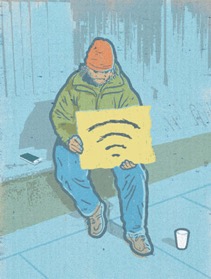Spectrum on Spectrum: Mitch Lazarus Writes About "The Great Radio Spectrum Famine"

In the article, Mitch compares the technological evolution and spectrum efficiency improvements of fixed microwave, TV, cellular, and private land mobile spectrum. TV spectrum had a huge increase with the DTV transition, called “digital dividend” for good reason in Europe. Similarly, the cellular crowd has had tremendous efficiency improvements also. Fixed microwave, Part 101, once had an mandatory efficiency requirement of 1 b/s, but now has minimum data rates of 2.5 to 4.5 b/s . Private land mobile, Part 90, is stagnating by comparison:
Not until 1992 did the FCC launch a "refarming" program to cut the standard 25-kHz bandwidth to 12.5 kHz, with plans for a further trimming to 6.25 kHz. Twenty years later a lot of 25-kHz equipment is still in use, and the FCC-required implementation of 6.25-kHz equipment is still years away. Users, happy with their inefficient radios, resist government efforts to take them away. In the meantime, the goals of the program have been overtaken by technology. Doubling and quadrupling capacity may have been worth the effort in 1992, but such a target seems almost pointless today. Cellphone systems can carry 10 to 100 times the amount of voice traffic in the same amount of spectrum by using a dense network of towers and taking advantage of digital encoding and data compression.
Part 90 improvement has always been slow because local government licensees are always strapped for funds and use political pressure to press for myopic policies. The spectrum community has been unable to come up with realistic policies that compensate Part 90 users for increased spectrum efficiency in exchange for access to spectrum freed up.
Mitch offers a novel suggestion to break the logjam:
Any solution ultimately has to identify the least efficient or least critical services and redesign them to use less spectrum. Consider, for example, the current situation with two-way radios: 12.5 kHz for a one-way voice channel, with many channels vacant at any given moment. Such radios are indispensable to police, firefighters, and other emergency responders, as well as utility workers, taxi drivers, plumbers, construction crews, and many others. But their collective traffic could be handled in far less spectrum than is being used today. Unfortunately, there's no practical way to improve these devices on their present frequencies, beyond the long-awaited halving of their bandwidth.
We need to offer these people a more efficient alternative while making it more costly for them to use their old equipment. Suppose the FCC gave a nonprofit industry group a few megahertz in which to provide efficient, digital, two-way radio service on an at-cost basis. To be sure, many users would prefer to keep their existing radio gear. But the FCC could make their licenses more expensive and equipment requirements more demanding, while pointing users to the new collective service as a better option.



![Validate my RSS feed [Valid RSS]](valid-rss-rogers.png)

